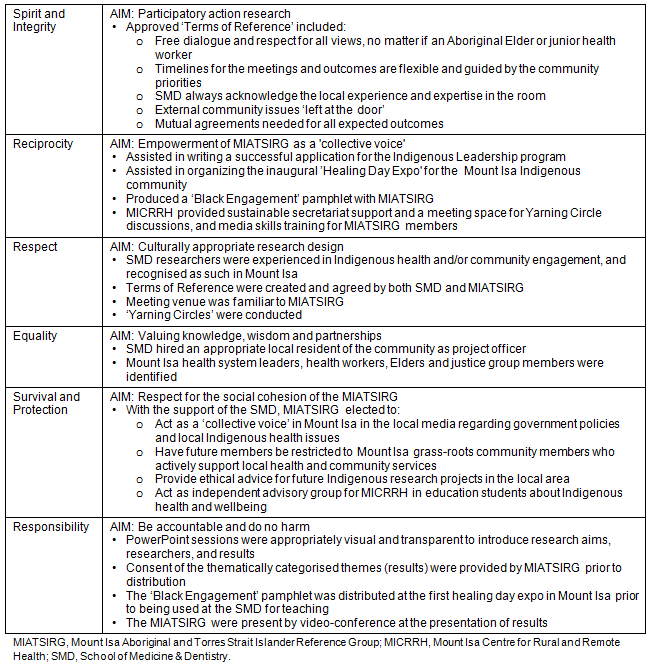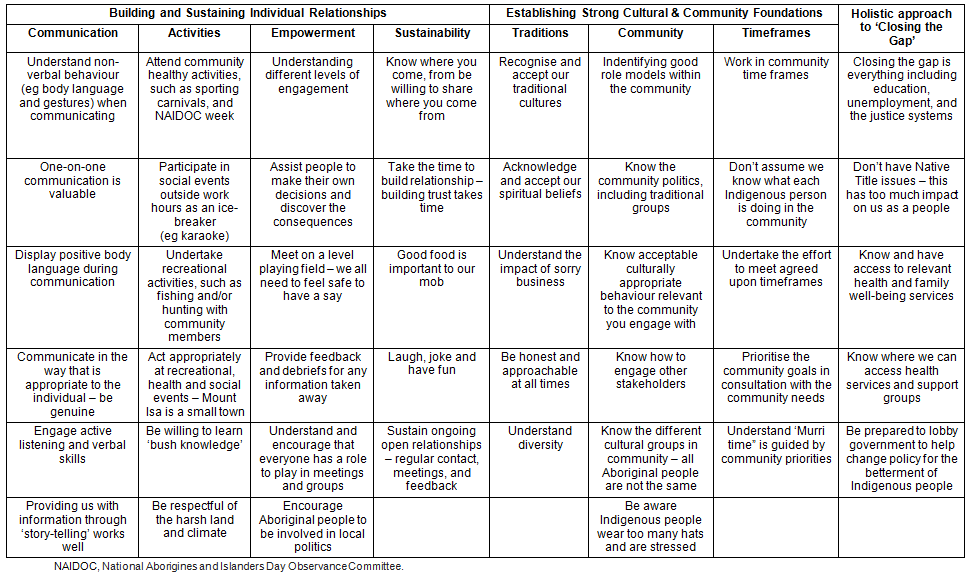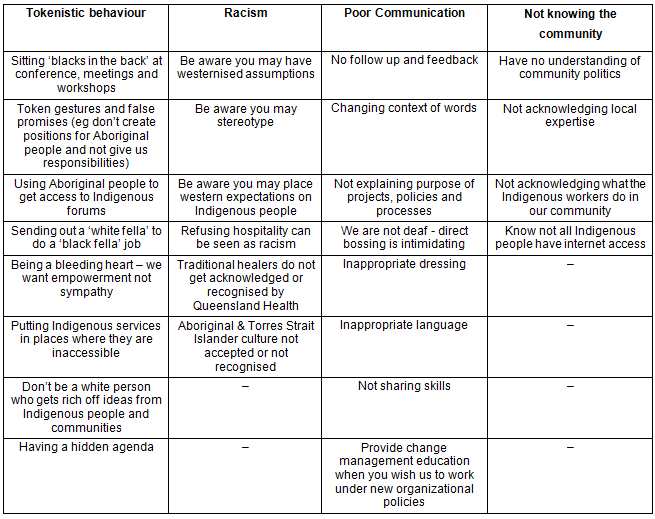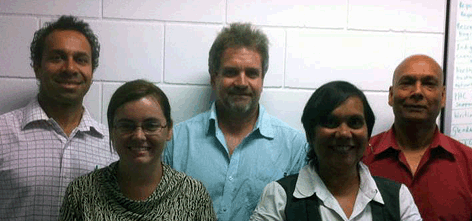Community engagement is a process that facilitates and maintains a connection between organisations and the community to improve governance or programs within the organisation and the delivery of services to the community. There is particular need for effective and culturally appropriate ways of engagement between medical schools and the individual local communities they serve. Medical schools have a responsibility not only to produce 'good' doctors, but to equip students with the necessary knowledge, skills and attitudes to engage with local communities during community placements, and later act as agents of change in addressing health system priorities and inequities after graduation. Such outcome qualities in medical graduates are important for them to be the future transformational leaders able to bridge the health service inequalities between Indigenous and non-Indigenous Australians.
The James Cook University (JCU) School of Medicine and Dentistry (SMD) is the only medical school in the North Queensland (NQ) region. The SMD was established in 2000 with the mission to work with rural, remote, tropical and Indigenous (Aboriginal and Torres Strait Islander) populations. A significant proportion of the undergraduate learning at the JCU SMD takes place in community settings; including 14 weeks of rural placement across Years 2, 4 and 6, and a one week placement in an Aboriginal Medical Service in Year 4.
Since inception, the JCU SMD has established relationships with individuals from local mainstream and Indigenous health organisations in order to facilitate student learning in regards to the rural community placement program, cross-cultural awareness and rural, remote, Indigenous and tropical health. In 2010 the SMD expanded its community engagement by developing a systematic process to build stronger and long-lasting relations with Indigenous health organisations and Indigenous health leaders by collaboratively establishing an Indigenous Reference Group (IRG) in the remote Indigenous community of Mount Isa (Mt Isa) in NQ. The aim of the engagement process was to:
- Create a long-lasting connection between JCU SMD and the Mt Isa Indigenous community;
- Improve the Indigenous program governance within the JCU SMD and improve the quality of graduates working in NQ communities in a culturally appropriate way; and,
- Build a set of good (and bad) engagement principles with the Mt Isa Indigenous community for both our staff and students.
This article primarily describes the process for how the SMD established the IRG, developed protocols for engagement, and negotiated reciprocal benefits for both parties so that this engagement will be sustainable. This paper also describes practical tips on how to engage with the Mt Isa Indigenous community, based on the 40 years of individual expertise and experience of the IRG in Indigenous engagement and health and wellbeing.
Setting and design
The study was conducted in 2011 within the NQ community of Mt Isa by researchers from the JCU SMD. The Mt Isa community numbers approximately 21 000, of which 15% (approximately 3200) are Aboriginal or Torres Strait Islander peoples1. A participatory action research design was used for this project. JCU SMD researchers selectively recruited an Indigenous project officer, who then approached key Mt Isa Indigenous health workers to form an IRG. Collaboratively, the Indigenous project officer and IRG members developed a Terms of Reference (ToR) that followed the values and ethics guidelines recommended for ethical conduct in Aboriginal and Torres Strait Islander health research. Later, the JCU SMD academics and the IRG agreed upon reciprocal benefits for the engagement. Approval was obtained from the JCU Aboriginal and Torres Strait Islander Research Ethics Committee (H3765).
Selection of the Indigenous Project Officer and IRG members
A committee of Indigenous researchers and Indigenous health academics at JCU purposively recruited an appropriate Indigenous project officer from the Mt Isa region. The project officer selected was from the local Kalkadoon and Waayni Indigenous community, and was well known and trusted in the Mt Isa community. The project officer already had existing local relationships and networks, including over 20 years of experience in Indigenous Australian communities implementing culturally appropriate programs in areas of crisis accommodation, family support services and child care. The project officer's extensive knowledge of capacity building and community engagement were a significant prerequisite for the study, as was her knowledge of the dynamics and the political issues in the Mt Isa Indigenous community.
The Mt Isa Indigenous participants (predominantly Aboriginal) approached were a cross-section of leaders from the healthcare system, Elders, and other non-professional but valued community representatives. The JCU SMD academics and project officer collaborated in selecting the IRG participants using Indigenous family, work and social networks. Individuals were selected who worked for Indigenous health and community organisations in Mt Isa, and who had shown previous initiative in improving the health and welfare of the local community. Potential IRG members were contacted by the project officer via telephone, followed by mail, and then an official letter of invitation in the post. The project officer informed them of the project, and asked if they wished to form an IRG to provide feedback to the JCU SMD about its undergraduate community placement program. All 13 Indigenous people approached chose to participate in the project, and agreed to meet in Mt Isa three weeks later.
Establishing the consultation process
In the weeks leading up to the first meeting, the project officer maintained constant contact with the potential IRG members. Community dynamics and priorities can change on a daily basis in Indigenous communities; therefore, it was paramount to keep up-to-date and maintain contact. Contact was often done in triplicate; for example, phone calls were followed up with an email and an official letter posted about the meeting. In addition, the project officer asked the Elders who were in the selected group to keep the others interested and focused on the initial meeting. A day before the meeting, the project officer went out to the Mt Isa community to inform participants about the project face-to-face and to identify - and be respectful of - any current sorry business or other community crises. The project officer's presence further assured attendance at the meetings, in particular, poor attendance at the meeting due to transport issues with the Indigenous Elders. This initial recruitment phase would likely have taken longer if the project officer had not been familiar with the community and community members, as the building of trust among participants is essential but takes time2.
The initial group discussion was held at the Mount Isa Centre for Rural and Remote Health (MICRRH), a venue familiar to the local Indigenous community. At the initial meeting, the Indigenous project officer was the sole representative of JCU SMD for the project. The project officer started the meeting by giving a PowerPoint presentation about the project; the presentation outlined the reasons why JCU SMD would like to collaborate with the Mt Isa Indigenous community, listed expected outcome benefits for both parties, and provided photographs and backgrounds of the JCU SMD team to introduce them. It was also made clear in the meeting that the JCU SMD would make every effort to turn the collaboration into a sustainable partnership. Those present were then asked if they would like to form a Mt Isa IRG for the project, and all 13 participants agreed. The group also chose to name themselves the Mount Isa Aboriginal and Torres Strait Islander Reference Group (MIATSIRG).
MIATSIRG and the project officer then refined a draft ToR (created prior to the first meeting by the JCU SMD academics and based on National Health and Medical Research Council [NHMRC] values and ethical guidelines on undertaking research in Aboriginal communities3) to be respected during all further correspondence and meetings. The second round of discussions in the afternoon (after a lunch involving healthy foods appropriate for diabetics) involved MIATSIRG talking about their experiences of how government organisations had previously engaged with the Mt Isa Indigenous community - both good and bad. A final meeting later in the year was held to discuss sustainability of the partnership; this meeting endorsed a proposal that MICRRH (a campus of the JCU) will support MIATSIRG as a community engagement partner. Reciprocal benefits for JCU SMD and MIATSIRG were also reaffirmed in this meeting.
Data collection and analysis
Group discussion on good/bad community engagement followed the 'Yarning Circles' approach (also called roundtable discussions) - a practice commonly used by Aboriginal society and previously in community engagement with North American Indigenous peoples4. The 'Yarning Circle' concept is a discussion between peers or participants of similar status for exchange of views, which encourages participants to speak without fear of repercussion. Statements of good/bad engagement were captured on butcher's paper, and later thematically categorised into similar concepts, with consensual validation, by six JCU researchers and the project officer5. This analysis created a list of the principles for good and bad engagement with the Mt Isa Indigenous community. Respondent validation was also undertaken at a further meeting with MIATSIRG approximately 6 weeks later, whereby the participants were provided with the list of principles of good/bad community engagement; the resulting discussion concluded that the list was accurate and no changes were needed.
Theoretical underpinnings of the engagement process
The research was designed to ensure that any consultation with the Mt Isa Indigenous community followed the NHMRC 'Values and Ethics: Guidelines for Ethical Conduct in Aboriginal and Torres Strait Islander Health Research'3. The alignment of the SMD-MIATSIRG engagement process and activities with NHMRC guidelines are summarised (Table 1).
Table 1: How the MIATSIRG-JCU Medical School engagement process followed
NHMRC guidelines for ethical conduct in Aboriginal and Torres Strait Islander health research

Terms of Reference
The ToR for engagement between the JCU SMD and MIATSIRG was refined over several discussions. The ToR describes the ground rules for a Yarning Circle discussion (participant behaviour, duration and frequency of meetings), the role of participants, and the criteria for maintaining active membership within MIATSIRG (for a complete list of the ToR items refer to Table 2). However, the ToR itself remains a 'working document' in case of naturally evolving changes to the engagement process.
Table 2: Terms of Reference for the MIATSIRG-JCU Medical School engagement process

Principles of good (and bad) engagement with the Mt Isa Indigenous community
A complete list of good and bad engagement strategies articulated by the MIATSIRG are provided (Tables 3 and 4, respectively). The principles of 'bad' engagement with the Mt Isa Indigenous community were associated within the four themes: tokenism, racism, poor communication, and 'not knowing the community'. 'Good' engagement with the Mt Isa Indigenous community can be summarised under three overall themes: building and sustaining individual relationships, establishing strong cultural and community foundations, and holistic approaches to closing the gap, with each of the 'good engagement' major themes consisting of several minor themes.
Table 3: Examples of good engagement, as proposed by members of the Mount Isa Indigenous community

Table 4: Examples of bad engagement, as proposed by members of the Mount Isa Indigenous community

Reciprocal benefits for MIATSIRG and JCU SMD
MIATSIRG members chose to be empowered with the knowledge, training and confidence to act as a 'collective voice' for the Mt Isa Indigenous community, advocating for local priority health and social issues, and organising community events. Specifically, MIATSIRG negotiated the following benefits:
- The SMD project officer to assist MIATSIRG members in organising an inaugural 'Healing Day Expo' for the Mt Isa Indigenous community.
- SMD to assist writing a written application for a MIATSIRG member to attend the Indigenous Leadership program (Certificate IV) at the Australian National University.
- MICRRH to provide secretariat support for the Yarning Circle discussions, as well as provide the room and food for the meetings.
- MIATSIRG members to be supported with media skills training at MICRRH.
The SMD negotiated the following benefits:
- A Yarning Circle with MIATSIRG when input is required into the undergraduate community placement programs and the Indigenous curriculum.
- List of the knowledge, skills and attitudes to assist students to better engage with local Indigenous communities. This list resulted in the collaborative production of a 'Black Engagement' pamphlet for the Mt Isa region, listing the principles of good and bad Indigenous community engagement. This pamphlet will be displayed in several Mt Isa health services as a resource to inform medical and other health students about how to better interact with Mt Isa Indigenous people and organisations while on placement6.
Discussion
While governments and organisations often claim they effectively engage with Indigenous communities, there is limited evidence to support this7. The outcome of this engagement process, however, has been demonstrably successful. The community partnership led to the JCU SMD receiving valuable feedback about how staff and students should engage with the Mt Isa Indigenous community, the MIATSIRG members received desired training and support, and the Mt Isa community enjoyed a Healing Day event. The MIATSIRG group is also now being further supported to provide a collective and representative voice for the Mt Isa Indigenous population in the local media.
This project has resulted in MIATSIRG members having greater skills and confidence to advocate for improving Indigenous health and social issues in Mt Isa, both with external organisations, such as the media, as well as internally within the local Indigenous community. It has been suggested that the health of Indigenous communities can be improved by providing training and mentoring to key Indigenous people who are permanently based in a community8. The successful outcome of this community engagement project further suggests that Australian medical schools are well positioned to undertake such approaches, as they have the skills and resources to empower key Indigenous people to undertake whole-of-community health activities.
There were several factors which likely resulted in the effective partnership with the Mt Isa Indigenous community and the successful outcomes. Yarning Circles were conducted in a friendly and appropriate manner, with sharing of stories at the introduction (including those of the JCU SMD academics), encouraging free and open dialogue, giving time for the group to vent, allowing the group to set the ground rules for the meeting, being flexible, and respecting the experience and expertise of Indigenous participants. The SMD team was also very clear at the initial meeting about the purpose of the engagement so that MIATSIRG fully understood what the project was about. The project also involved constant contact with MIATSIRG to ensure progress, and followed NHMRC guidelines for engaging with Aboriginal communities3 - in particular, providing reciprocal benefits, where knowledge is not just taken from the community, but given back. Further, there was a strong desire across both sides to improve the health of the Mt Isa Indigenous community and improve the cultural awareness of future medical graduates in their community.
A limitation to this study, however, is that only one Indigenous community was involved. Therefore, the ToR, Indigenous engagement strategies and desired reciprocal benefits listed are for Mt Isa only, and specific examples of 'good' and 'bad' Indigenous engagement strategies would likely be different for other communities.
This project shows that successful and sustainable partnerships can be initiated between a medical school and a remote Indigenous community. The process described here allows Indigenous participants to guide the engagement, and negotiate the reciprocal benefits that required both parties to follow through on. The preliminary outcomes of this partnership shows not only that Indigenous reference groups are a great resource for providing grass roots information and Indigenous perspectives for improving the medical school curriculum, but also that medical schools can help Indigenous communities to plan community-wide activities to help 'Close the Gap' in the health of Indigenous peoples.
Acknowledgements
Concepts around effective community engagement were developed through the input of the Mount Isa Aboriginal and Torres Strait Island Reference Group (MIATSIRG): Ron Page, Leanne Parker, Nancy George, Renee Blackman, Stephanie King, Caterina Walden, Darren Walden, Graham Page, Frances Page, Dolly Hankin, Fiona Hill, Kerry Major, Shaun Solomon, Elizabeth Dempsey and Mona Phillips. The authors gratefully acknowledge the MICRRH organisation in Mount Isa for supporting the project with all the required resources, and the Indigenous academic Priscilla Page from James Cook University School of Medicine and Dentistry for assisting with data analysis.
References
1. Australian Bureau of Statistics. Australian Historical Population Statistics (cat. no. 3105.0.65.001). Canberra, ACT: 2006. Available: http://www.censusdata.abs.gov.au/census_services/getproduct/census/2011/communityprofile/LGA35300?opendocument&navpos=100 (Accessed 17 April 2013).
2. The Australian Institute of Aboriginal and Torres Strait Islander Studies. Guidelines for Ethical Research in Australian Indigenous Studies, 2nd edn. (Online) 2011. Available: http://www.aiatsis.gov.au/research/ethical.html (Accessed 17 April 2013).
3. National Health and Medical Research Council. Values and ethics: Guidelines for ethical conduct in Aboriginal and Torres Strait Islander health research. Canberra, ACT: NHMRC, 2003. Available: http://www.nhmrc.gov.au/guidelines/publications/e52 (Accessed 13 February 2012).
4. Graveline FJ. Circle as methodology: Enacting and Aboriginal paradigm. International Journal of Qualitative Studies in Education 2000; 13(4): 361-370.
5. Patton M. Qualitative research and evaluation methods, 2nd ed. Newbury Park, CA: Sage, 1990.
6. Woolley T, Sivamalai S, Ross S, Duffy G, Miller A. Indigenous perspectives on the desired attributes of medical graduates practising in remote communities: a Northwest Queensland Pilot study. Australian Journal of Rural Health 2013; 21(2): 90-96.
7. Dillon MC, Westbury ND. Beyond humbug: transforming government engagement with Indigenous Australia. West Lakes, SA: Seaview, 2007.
8. Tcharos E, Vallance, R. Research in Aboriginal communities: cultural sensitivity as a prerequisite. AARE Nov 28 - Dec 2, 2004. Melbourne, VIC: The University of Melbourne, 2004.





